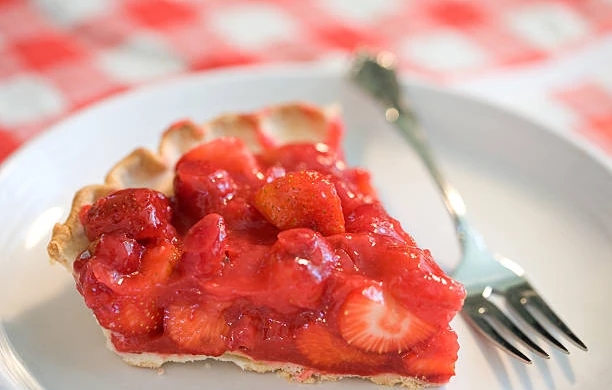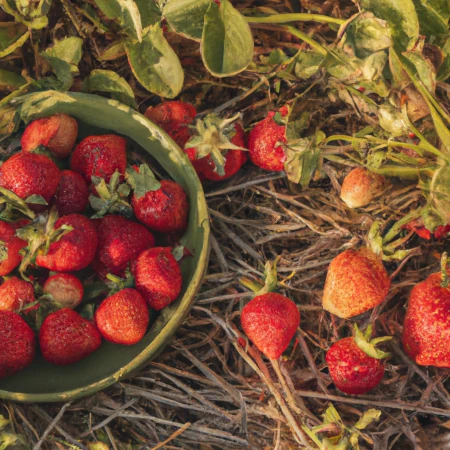Granny's Strawberry Pie

Granny's Strawberry Pie is the classic combination of ripe berries and heavy cream. This is a favorite summertime dessert recipe that highlights one of the season’s sweetest harvests. Fresh mashed berries are heated with sugar to create a perfectly sweet fruity filling. And a generous dollop or three of a light and fluffy whipped cream is the ideal topping for this strawberry pie celebration.
Great for picnics, birthday parties, or 4th of July cookouts, Granny's Strawberry Pie will inspire new memories.

Ingredients
1 cup granulated sugar 3 tablespoon cornstarch 1 tablespoon lemon juice 1 quart strawberries 3⁄4 cup water For the Topping
1 cup (240 milliliters) heavy cream 1 tablespoons powdered sugar
Method
- 1. Make one of Granny's all-purpose pie crusts.
- 2. Cut enough strawberries into thin slices to cover the pie crust. Arrange sliced berries in baked pie shell.
- 3. Mash the remaining berries and combine with sugar in a saucepan. Bring to a boil.
- 4. In a small bowl, whisk cornstarch and water. Stir into boiling berry mixture. Reduce heat and simmer for 10 minutes.
- 5. Pour in baked pie shell. To make the topping, whip cream and powdered sugar until soft peaks form. Refrigerate until ready to serve.

The Roots of Strawberry Pie in American Cuisine

The story of strawberry pie is deeply intertwined with the agricultural and cultural history of the United States. From the wild forests of North America to carefully cultivated fields, strawberries have transformed from a simple forest fruit to a beloved dessert that represents far more than just a sweet treat. Native Americans had long enjoyed wild strawberries, but it was the European settlers who would ultimately develop this humble fruit into a culinary tradition that would become deeply embedded in American food culture.
Native strawberry varieties like the Virginia strawberry (Fragaria virginiana) and the beach strawberry (Fragaria chiloensis) were remarkable in their diversity and intensity of flavor. These early varieties presented both challenges and opportunities for early farmers and home cooks. The fruit's journey from wild forest delicacy to cultivated crop mirrors the broader narrative of American agricultural development—a story of adaptation, innovation, and persistent human creativity.
Cultivation, Variation, and Cultural Significance
The 19th century marked a pivotal moment in strawberry cultivation and culinary history. As agricultural techniques improved and transportation networks expanded, strawberry farming evolved from a local, seasonal activity to a significant economic enterprise. States like California, Oregon, and Florida emerged as major strawberry producers, each developing unique cultivation methods adapted to their specific microclimates.
Regional variations of strawberry pie reflect the diverse cultural landscape of the United States. Different regions developed unique approaches to this classic dessert:
- Southern versions often include a layer of cream cheese for added richness
- New England pies might incorporate maple syrup or a custard-like base
- Midwestern recipes tend to be more rustic and less sweet
- West Coast variations frequently experiment with heirloom strawberry varieties
Preservation techniques played a crucial role in the strawberry's culinary evolution. Before modern refrigeration, families relied on methods like canning, jam-making, and pie-baking to extend the fruit's limited seasonal availability. Strawberry pies became more than just a dessert—they were a way of capturing and celebrating the brief, intense strawberry season, transforming practical necessity into a cherished cultural tradition.
A Living Culinary Heritage
Contemporary strawberry pie recipes continue to evolve, reflecting ongoing culinary innovations and changing dietary needs. Artisanal bakers experiment with heirloom varieties, while home cooks adapt recipes to accommodate dietary restrictions, creating vegan, gluten-free, and other alternative versions of this classic dessert.
At its core, strawberry pie represents a form of edible family history. Passed down through generations, each pie tells a story of migration, adaptation, and culinary creativity. The act of making the pie becomes a way of connecting with family roots, preserving cultural memory, and celebrating the enduring power of shared meals. It is a living culinary tradition that continues to bridge past and present, rural and urban, traditional and innovative.
More than just a simple dessert, strawberry pie embodies the resilience, innovation, and shared experiences that have shaped the nation's culinary landscape. It remains a beloved treat that captures the essence of American agricultural abundance and cultural diversity, with each slice telling a unique story of creativity, tradition, and connection.
Bon appétit!